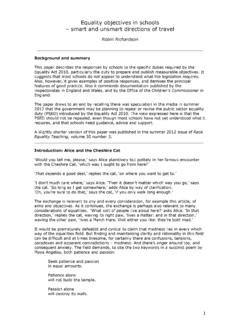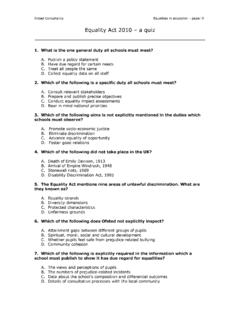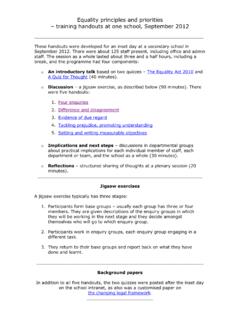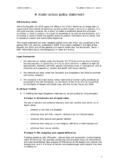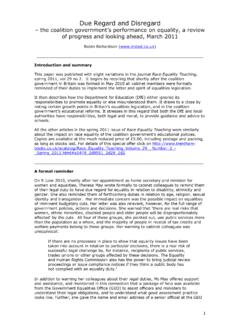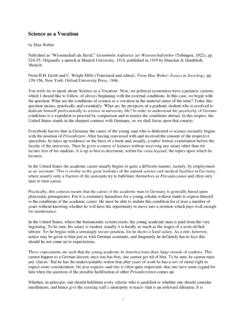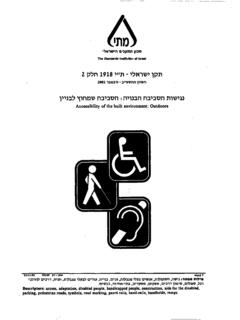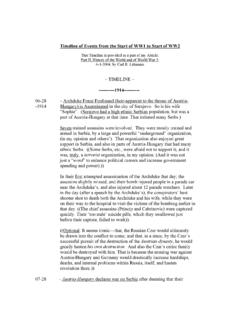Transcription of Equalities in the UK: a timeline since 1918
1 1 Insted Consultancy Equalities in education paper 8 Equalities in the UK: a timeline since 1918 _____ Introductory note The items in this list are nearly all about the development of legislation in the UK. The list also contains, however, some references to the wider international context, and to seminal reports and iconic events. It does not, of course, aim to be exhaustive. At the end, there are links to more detailed lists relating to specific strands. _____ 1918 On 6 February royal assent is given to the Representation of the People Act: women may now vote in general elections providing they are over the age of 30 who are householders or the wives of householders, or occupiers of property with an annual rent of 5, or graduates of British universities.
2 1928 Equal Franchise Act is given royal assent on 2 July: women now have the vote on the same terms as men. They use it for the first time on 30 May 1929. 1948 SS Windrush docks at Tilbury on 22 June: symbolic birthday of multi-ethnic Britain 1948 10 December, the Universal Declaration of Human Rights sets the global framework for Equalities legislation in the decades to follow 1949 La Deuxi me Sexe by Simone de Beauvoir, translated three years later into English: foundational text on gender equality, and on concepts of self and other 1955 Brown v. Board of Education, landmark case in the United States, rules that concept of separate but equal is unlawful 1957 The Wolfenden Report published on 7 September: turning point in official attitudes towards countering homophobia in western countries 1963 Civil Rights March on Washington and Dr King s I have a dream speech 1967 Sexual Offences Act receives royal assent, partially decriminalising sex between men 1969 Colour and Citizenship: a report on British race relations by Rose and co-authors, foreword signed off in February.
3 Critical review of government policies 1969 On 28 June the Stonewall Riots in New York are the symbolic start of campaigns for full sexuality equality throughout western countries 1975 Sex Discrimination Act, introducing the concept of indirect discrimination into UK law and setting up a powerful enforcement agency, the Equal Opportunities Commission 1976 Race Relations Act, building on two Acts of the previous decade: stress on avoiding indirect discrimination and setting up of a powerful enforcement agency, the Commission for Racial Equality 1978 The Warnock Report: foundational text on special educational needs 21985 The Swann Report (Education for All), published in March: report of the committee of inquiry into the education of children of ethnic minority groups 1995 Disability Discrimination Act addresses the discrimination that many disabled people face.
4 Different parts of the legislation take effect at different times, and the original Act has been subject to several amendments. Key concepts include reasonable adjustment and, more recently, the social model. 1995 Beijing Women s Conference, boost to gender equality issues throughout the world 1996 Constitution of the Republic of South Africa, 4 December: unlawful for the state to discriminate on grounds of race, gender, sex, pregnancy, marital status, ethnic or social origin, colour, sexual orientation, age, disability, religion, conscience, belief, culture, language and birth.
5 1998 Human Rights Act 1998 and Article 14 of the European Convention on Human Rights state that the enjoyment of the rights and freedoms set forth in the Convention shall be secured without discrimination on any ground such as sex, race, colour, language, religion, political or other opinion, national or social origin, association with a national minority, property, birth or other status . 1998 Fair Employment and Treatment (Northern Ireland) Order making it unlawful to discriminate on grounds of religious belief and/or political opinion (later amended to include other dimensions of equality too) 1999 Report of the Stephen Lawrence Inquiry (The Macpherson Report): the concept of institutional racism introduced into public consciousness and debate 1999 Disability Rights Commission Act sets up a powerful enforcement body 2000 Race Relations (Amendment) Act.
6 Places a positive duty on public authorities to promote race equality, and requires each to produce a race equality scheme (RES) and regular race equality impact assessments (REIAs). 2000 Equality: a new framework by Bob Hepple, Mary Coussey and Tufyal Choudhury prepares the way for a holistic approach to Equalities legislation 2000 European directives on race and employment set the international context in which UK Equalities legislation will develop through the coming decade. 2000 The Future of Multi-Ethnic Britain (The Parekh Report) stresses three essential values: equality; recognition and respect for difference; and cohesion and a sense of shared belonging.
7 2003 On 10 July 2003 the House of Lords votes overwhelmingly to repeal Section 28 of the Local Government Act in England and Wales. 2003 Employment Equality (Religion or Belief) Regulations come into force on 2 December: unlawful to discriminate in employment on grounds of religious affiliation 2003 Employment Equality (Sexual Orientation) Regulations come into force on 1 December: unlawful to discriminate in employment on grounds of sexuality 2004 Civil Partnership Act receives royal assent on 18 November, giving same-sex couples the same rights and responsibilities as married heterosexual couples.
8 It comes into operation on 5 December 2005. 32005 Disability Discrimination Act places a positive duty on public authorities to promote disability equality, and requires each to produce a disability equality scheme (DES) and regular disability equality impact assessments (DEIAs). 2005 Employment Equality (Age) Regulations come into force on 1 October 2006 Equality Act receives royal assent on 16 February: extends religion or belief and sexual orientation regulations to cover service delivery as well as employment; places a positive duty on public authorities to promote gender equality.
9 And requires each to produce a gender equality scheme (GES) and conduct regular gender equality impact assessments (GEIAs) 2006 The Racial and Religious Hatred Act receives royal assent on 16 April, amending the Public Order Act 1986, creating offences involving stirring up hatred against persons on religious grounds 2007 Public authorities increasingly combine their RES, DES and GES into a single equality scheme (SES), and their REIAs, DEIAs and GEIAs into single equality impact assessments (EQUIAs) 2007 Equality Act (Sexual Orientation) Regulations 2007 become law on 30 April, making discrimination against lesbians and gay men unlawful in the provision of goods and services.
10 2007 The CRE, EOC and DRC cease to exist and from 1 October are brought together into the Equality and Human Rights and Commission (EHRC). 2008 In the Queen s Speech on 3 December it is confirmed a new Equality Bill will be published in 2009 and that a single equality duty will require public bodies to consider the diverse needs and requirements of their workforce, and the communities they serve . 2009 On 17 January President Obama announces wide-ranging developments and improvements in Equalities legislation in the United States. 2009 The Equality Bill is published on 27 April and in the following weeks several consultation exercises are initiated in connection with it.

